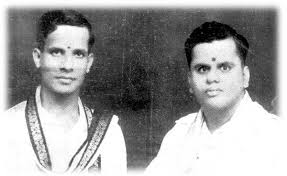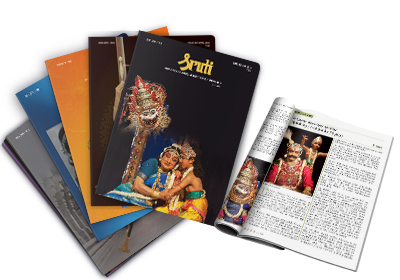
Srinivasa Ayyar: (October 20, 1912 - October 9, 1980)
Sivasubramania Ayyar: (1916 - June 28, 1965)
Sivasubramania Iyer (Subbaiyer) and Srinivasa Iyer - popularly known as the Alathur Brothers, were Carnatic Classical vocalists of the 20th Century. This star duo were not brothers by birth but performed together as they were both disciples of Sivasubramaniam Iyer’s father, Alathur Venkatesa Iyer.
But both started their training in music under Venkateswara Ayyar and there ensued an enduring musical coparcenary fostered by common training and cemented by a spiritual bondage sans jealousy. Of course, there did occur differences once when the Music Academy, Madras decided to confer the prestigious title of 'Sangita Kalanidhi', Srinivasa wanted the other to receive first being the son of his guru and an equal partner, his own age being secondary, while Sivasubramania would not accept it saying that seniority in age alone counted. Finally it was resolved to cast lots before the photo of the Guru and the title went to Sivasubramania Ayyar in 1 964; and Srinivasa Ayyar got it in 1965. (The title is yet to be given jointly as is done in the case of Nobel Prize,) Sivasubramania was seven and Srinivasa was eleven when they started their training under the father of the former Srinivasa Ayyar was a scholar in Sanskrit, was Secretary to the Tyagabrahma Mahotsava Sabha, Tiruvaiyaru and was the son-in-law of Valadi Krishna Ayyar, an eminent musician and teacher. Pudukottai Dakshinamurti Pillai was their close friend, philosopher and guide and the Karaikudi Veena Brothers were their patrons. Sivasubramania Ayyar played on veena and kanjira for sometime and was intimately associated with the percussion maestros, Palghat Mani Ayyar and Palani Subramania Pillai.
Alathur Brothers were the fourth generation disciples of Sri Tyagaraja through Manambuchavadi Venkatasubba Ayyar. The two musicians had thus imbibed the best of music and laya through inheritance, training and association.
The Duo made their debut in 1 928 at the Tyagaraja Festival, Tiruvaiyaru and then gave a performance during the Guru Pooja in the famous Dakshinamoorthi Temple, Tiruvarur in 1928 and soon shot into fame and popularity. Were noted for their true traditional values and specialisation in laya and pallavi. They synchronised well, had attractive voice-blend and enjoyed a wide repertoire.
Apart from the honours from the Music Academy, the Travancore Court appointed them as Asthana Vidwans. The fact that the brothers were both honoured by the Academy separately shows the high level of expertise and talents they enjoyed both individually and collectively. Sangita Nataka Academy Award was presented to Srinivasa Ayyar in 1 968. Alathur Brothers had no peers among duos in expertise, elegance, fame and stature.
Combining the strengths of various aspects of Carnatic music – Laya , lakshana and Laskshya- they established a style of music for themselves. Their patantaram of kritis of Trinity, Tirupugazh, compositions of Meesu Krishna Iyer, Swati Tirunal and Ragam Tanam Pallavis were of a very high standard.
The finesse and authority with which they handled compositions like Vidulaku Mrokeda (Mayamalavagowla, Tyagaraja), Mari Mari Ninne (Kambhoji, Tyagaraja), Epapamu (Atana, Tyagaraja), Shantamu Lekha (Sama, Tyagaraja), Kalinarula (Kuntalavarali, Tyagaraja), Koniyadina (Kambhoji, Veena Kuppaiyer), Shree Matha Shiva (Begada, Muthuswami Dikshitar), Kanulara Kanti (Dhanyasi, Wallajahpet Venkatramana Bhagavatar) were essays into the very depths of the most authentic of Carnatic music.Compositions in Tamil like Sivanai Ninaindhavar (Hindolam, Kavikunjara Bharathi) sparkled in their exposition.
The Alathur brothers performed with most of the star accompanists of the world of Carnatic music. On the violin, they were accompanied by Thiruvalangadu Sundaresa Iyer, Mayavaram Govindaraja Pillai, Kumbakonam Rajamanickam Pillai, and Mysore T. Chowdiah among others. Later T. N. Krishnan and Lalgudi G. Jayaraman accompanied them in most of their concerts while Kandadevi Azhagirisami accompanied them in a few.On the Mrudangam many vidwans like Pudukottai Dakshinamoorthy Pillai, Pazhani Subramania Pillai and Palghat Mani Iyer accomapanied them .
Their expositions of Ragam Tanam Pallavi with Lalgudi Jayaraman on Violin, Mani Iyer on Mrudangam and Pillai on Kanjira were enjoyed by experts and laymen.


